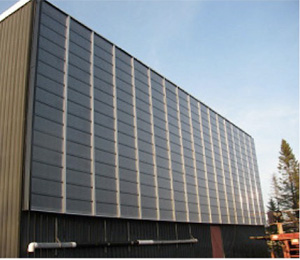Blog Post
Transpired Solar Collector Performance: More Than Hot Air

Conserval's SolarWall was the pioneer in the transpired solar collector market, but innovations abound. How do the newer systems measure up?
Besides Conserval's SolarWall (the first transpired solar heating system on the market) and ATAS's InSpire system, there are two Canadian companies now offering transpired solar air heating systems in the U.S.: Matrix Energy's MatrixAir TR and Enerconcept Technologies' Lubi system.
(NB: These links are available to GreenSpec subscribers.)
Solar air heating, a simple concept?
Solar air heating is a relatively simple technology whereby metal panels are installed a few inches away from the south-facing exterior wall or roof of non-residential buildings. When the sun hits the panels, the air in the gap between the building and the panel is heated and pulled into the HVAC system to preheat incoming ventilation air. Solar air heating can be a low-cost, effective way to lower a building's energy use, particularly in applications that demand a lot of fresh air, like warehouses, factories, and box stores.
The two main types of solar air heating panels are "back pass" systems that use solid panels and "transpired" systems that are perforated to allow air through--and there is a big performance difference between the two. Back pass assemblies are not as efficient, because much of the heat on the exterior of the panels radiates off the surface, and the heat on the interior of that panel is not removed as efficiently. With a transpired system, however, much of the heat on the panel's exterior is drawn in through the holes in the panel via negative pressure, where the air can then be drawn into the HVAC system.
MatrixAir TR metal transpired system
Matrix's MatrixAir TR transpired system uses either galvanized steel or aluminum panels, but draws air out of the plenum from the bottom of the exterior wall rather than the top (SolarWall pulls from the top). MatrixAir is angled slightly whenever possible to make it more efficient at gathering solar radiation, and the company claims that removing the air toward the base of the system is very effective since hot air can get "trapped" at the top of other transpired systems and is not effectively removed. But there does seem to be a performance tradeoff, as the Canadian Standards Association (CSA) certifies this system as having a slightly lower performance factor than SolarWall.

Enerconcept's Lubi, using glazing to improve performance
Enerconcept's Lubi is also a transpired system, but instead of metal it is a glazed system that uses perforated 35.6" x 12.6 UV-resistant polycarbonate panels (the same material used in car headlights). Like SolarWall, Lubi also pulls air from the top of the assembly, but Lubi allows light through to the building wall. According to Christian Vachon, president of Enerconcept Technologies, metal transpired systems require dark surface colors, and some of the heat collected by those panels is lost off the surface of metal. These losses are more pronounced in windy conditions. The Lubi glazed transpired system has been declared insensitive to wind by the Solar Rating and Certification Corporation (SRCC). Little heat is lost off the surface; it is instead collected within the plenum. And the numbers from the CSA appear to confirm this, as the Lubi system has a significantly higher performance factor than MatrixAir or SolarWall.
SUPPORT INDEPENDENT SUSTAINABILITY REPORTING
BuildingGreen relies on our premium members, not on advertisers. Help make our work possible.
See membership options »Of course, thermal mass and color of the building's exterior impact the amount of heat generated by the Lubi system, but according to Vachon, "The penalty for going with a lighter color is much less with Lubi than with a metal transpired system." Using a white color, for instance, the Lubi is 50% more efficient than a similar metal system. This might make it a more attractive option for architects who don't want to be locked into dark cladding.
 Though the technology is not particularly complicated, all transpired systems require careful implementation between the architect, engineers, and those installing the HVAC systems. "It's quite a challenge bringing these people together," said Vachon. In some cases, such as retrofit projects, Enerconcept simplifies the process by offering turnkey systems that include collector, ventilation system, ducts, dampers, controls, and even subsidies.
Though the technology is not particularly complicated, all transpired systems require careful implementation between the architect, engineers, and those installing the HVAC systems. "It's quite a challenge bringing these people together," said Vachon. In some cases, such as retrofit projects, Enerconcept simplifies the process by offering turnkey systems that include collector, ventilation system, ducts, dampers, controls, and even subsidies.
What will it cost?
The costs of these systems depend on the building and a variety of other factors. According to Matrix, its system has a return on investment of about five years. Enerconcept estimates an installed Lubi costs about $22–$25 per square foot compared to a metal transpired system at between $15 and $20, but the increased efficiency of the system should make up for some of the first costs.
BPA-free?
Though the production and manufacturing of the steel and aluminum used in most transpired systems have significant environmental impacts, polycarbonate has its own drawbacks. Bisphenol A (BPA), an endocrine disruptor found in some baby bottles, cans, and other consumer goods, is also used in the production of polycarbonate. Though there is little risk of BPA exposure to building occupants with most polycarbonate building products, there could be exposure risks at the manufacturing level.
Brent Ehrlich is the products editor at BuildingGreen, Inc.
Published May 9, 2011 Permalink Citation
(2011, May 9). Transpired Solar Collector Performance: More Than Hot Air. Retrieved from https://www.buildinggreen.com/news-article/transpired-solar-collector-performance-more-hot-air



Add new comment
To post a comment, you need to register for a BuildingGreen Basic membership (free) or login to your existing profile.